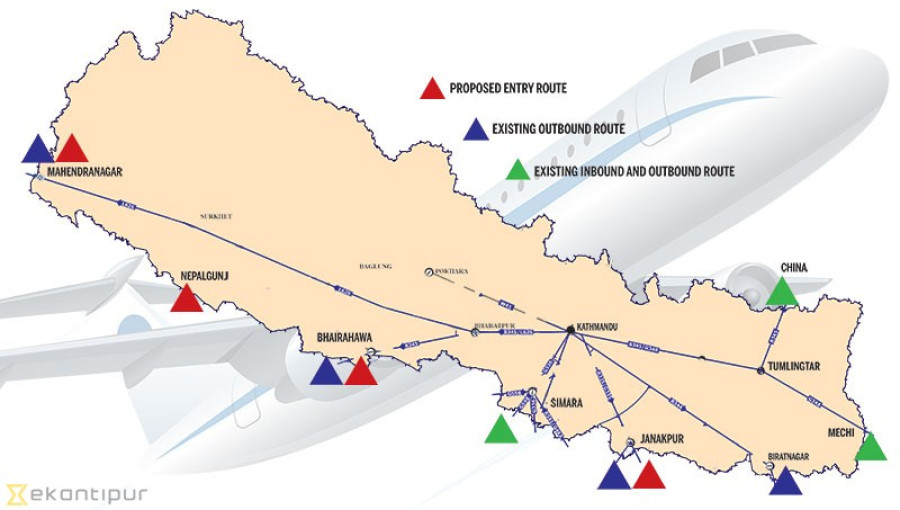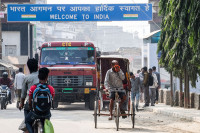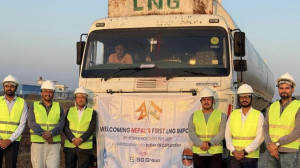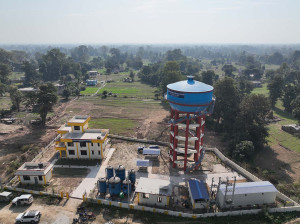Sat, Dec 13, 2025
Money
Nepal, India air route talks keep going round in circles
Nepal and India made little progress at the highly anticipated air route talks held in Mumbai, India last week. Nepal has been badgering the southern neighbour to grant air entry points through the L626 Mahendranagar route and Nepalgunj to facilitate aircraft movement to the two upcoming international airports in Bhairahawa and Pokhara.
bookmark
Sangam Prasain
Published at : January 22, 2019
Updated at : January 23, 2019 07:03
Kathmandu
Nepal and India made little progress at the highly anticipated air route talks held in Mumbai, India last week. Nepal has been badgering the southern neighbour to grant air entry points through the L626 Mahendranagar route and Nepalgunj to facilitate aircraft movement to the two upcoming international airports in Bhairahawa and Pokhara.
As a follow-up, high-level Nepali and Indian teams met during the two-day Global Aviation Summit held in Mumbai. Officials claimed making great progress, but little was achieved, according to people close to the discussions.
“As always, the Indian side convinced the Nepali delegation that it was positive about opening up the air entry points to Nepal,” a source privy to the matter said. “The Indian delegation said that they were trying to study the feasibility of the entry points Nepal has sought.”
According to Indian daily The Hindu, India’s Ministry of Civil Aviation has agreed in principle to grant air entry points through the L626 route in Mahendranagar. It said that pilgrims headed to Kailash Manasarovar from New Delhi would now be able to fly directly to one of the key entry points at Nepalgunj, and avoid the 11-hour drive from Kathmandu.
Director general of the Civil Aviation Authority of Nepal Sanjiv Gautam, who met Indian civil aviation officials on the sidelines of the meeting, confirmed the development. “But until we receive confirmation in writing, we cannot say anything.”
This route is unworkable for the international airport in Bhairahawa as it only permits entry to low-level flights (below 24,000 feet). This is good for small planes like the ATR, but not large jets that are expected to use the new airports. During various discussions over the past years, India has reportedly ‘denied’ granting an entry point through Mahendranagar due to heavy traffic in Indian airspace.
Read:
Nepal prods India for new air routesAnother development in Mumbai is the Bravo 345 route (currently Kathmandu-Bhairahawa-Lucknow) passing through the airspace over Bhairahawa. According to Gautam, Indian authorities said that they were in the final stage of making the route bi-directional. The Indian side has sent the new specified route proposal to the International Civil Aviation Organisation (ICAO), but that too will not work for Gautam Buddha International Airport in Bhairahawa which is expected to be completed this year, he said.
According to an air traffic management expert, there will be no problem for aircraft leaving Nepal as they can gain altitude after entering Indian airspace. But inbound aircraft will need to fly at a low altitude in Indian airspace for a long time.
“Normally, India will not allow aircraft to fly lower than 10,500 feet in its airspace. Even if it does so, aircraft will need to circle in Nepali airspace for 4-5 minutes before landing,” the expert said. “It’s not feasible, but it can be workable if the entry point through Nepalgunj is not granted.”
The entry point through Bhairahawa is fine for Pokhara International Airport which is scheduled to be ready before the monsoon in 2021. “The entry points through Nepalgunj and Mahendranagar are the most feasible for both upcoming airports as aircraft will have adequate time in Nepali airspace before landing,” he said.
If the entry points through Nepalgunj and Mahendranagar are not granted, international flights to Bhairahawa from the west or New Delhi will have to make a 300-km detour to Simara to enter Nepali airspace. Pokhara-bound flights from the west will have to make a 185-km detour if the new cross-border air routes are not opened.
The detours that aircraft bound for Bhairahawa and Pokhara will have to make will raise the operating cost for airlines and make flights costly. In the past, India has expressed reservations about providing entry points through Bhairahawa and Nepalgunj as a defence establishment is located in Gorakhpur where fighter jet exercises are held regularly.
Cross-border airspace issues have been pending for the last five years. Nepal formally asked India to open the new cross-border air routes during Indian Prime Minister Narendra Modi’s visit to Kathmandu in 2014. The issue of new air routes was also on the agenda during the Indian premier’s visit to Nepal last May.
Nepal has been pushing the agenda of new routes for the last nine years, as there exists a single entry point in Simara for most of the airlines flying into the country. In contrast, there are seven exit points for aircraft flying out of Nepal—Bhairahawa and Mahendranagar in the west; and Simara, Biratnagar, Tumlingtar, Kakarbhitta and Janakpur in the east.
Besides Simara, two other entry points over Mechi and Tumlingtar (over Everest) have been specifically designated for flights coming from Bhutan and Lhasa, respectively. The Simara entry point is used by a majority of aircraft flying into Nepal and is, therefore, congested most of the time.
Most Read from Money
Record graft case filed over China-funded Pokhara airport
Nepal set to allow Indian high-value notes after a decade-long ban
Public savings at risk as debt-ridden Nepal Airlines’ finances spiral
Private company starts import and supply of LNG in Nepal
Springs and groundwater shrinking across Nepal, ADB assessment warns
Editor's Picks
Public savings at risk as debt-ridden Nepal Airlines’ finances spiral
Hypertension and diabetes driving eye crisis in Kathmandu Valley
Bureaucratic hurdles, legal failures force father and daughter to take their own lives
Record graft case filed over China-funded Pokhara airport
Drone helps farmers tackle old challenges
E-PAPER | December 13, 2025
×




 18.12°C Kathmandu
18.12°C Kathmandu













